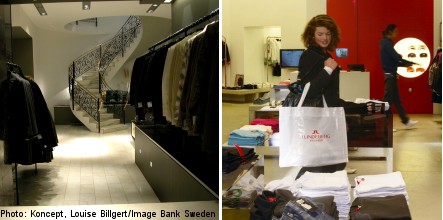Sweden is often misunderstood. Namely the common perception – well, outside of Scandinavia, anyway – that Swedish design is boring. Ask any foreigner to name an iconic local brand, and the likes of Ikea and Volvo will invariably come to mind. But for those in the know, Sweden has long been a hotbed for refined, cutting-edge design – and, no, we’re not talking generic, do-it-yourself kitchens.
Swedish fashion is in vogue. And it extends far beyond northern Europe and H&M’s ever-growing worldwide domination. Stockholm has emerged as the new Milan, minus the attitude and 24-hour panini stands. In the space of a decade, Sweden has emerged from seeming sartorial abyss to purveyor of understated, sophisticated cool.
That prominent local labels Acne Jeans, J. Lindeberg and Nudie Jeans (just to name a few) have each developed such a devout following amongst London, Paris and New York’s fashion savvy speaks for itself.
Look at the bigger picture, and you begin to understand why. It’s something that extends far beyond fashion. Sweden has become a Mecca, of sorts, to design purists around the world. The upshot being that local designers (fashion, industrial, architectural, whatever) are some of the most sought-after around the world.
As for fashion, what’s refreshing is that designers here are largely anti-fashion and far from evangelistic. Global success aside, there’s little regard for what’s going on (trends in fashion, basically) outside Scandinavia – a rare trait in the somewhat fickle world of fashion.
So has the rest of the globe simply cottoned on (pardon the pun) to our take on style? In short: yes. Spend time in, say, London or New York, and you see, firsthand, Swedish fashion’s far-reaching influence – fashion is progressively becoming more minimal, discreet and sober. Sound familiar? Yes, all hallmarks of typical Scandinavian style. What’s more, the success abroad of the aforementioned brands has opened the floodgate for the country’s myriad of stylish, sophisticated labels. Put simply: the world is ripe for Swedish fashion.
Established labels
J. Lindeberg has long been championed by the likes of Brad Pitt and the PGA’s fashion conscious. While it’s become somewhat “international” – namely that founders Stockholm-born Johan and Italian wife Marcella are now based in New York – collections are still decidedly Swedish.
“Take London – I think the new independent Sweden fashion movement fits the local scene well,” says the ex-Diesel designer, who spent five years in the British capital establishing the label.
“And it’s introducing people to a look that’s much simpler and more sophisticated.”
How would he describe J. Lindeberg?
“Elegant bohemian – a sharp tux, a leather jacket with attitude, a blazer and jeans.”
Nudie Jeans has become the label of choice for denim purists around the world. So much so that the Gothenburg-based jeans purveyor is now stocked in 45 countries.
The attraction?
It remains solely committed to producing exceptionally crafted jeans – pure and simple. What’s more, the brand personifies anti-fashion. Outside of Scandinavia, respected international style magazines have even gone as far as coining Nudie as the new (über-quality) Levis.
Worldwide, Acne Jeans (‘Acne’ is actually an acronym for Ambition to Create Novel Expressions) has emerged as the new Helmut Lang – albeit more affordable.
What’s interesting is that the brand’s success is underpinned by founder Jonny Johannson’s penchant for reconstructing each collection.
“Jeans aside, I set out to reinvent the brand all the time” says Johansson.
“This is something we’ve done from the beginning, so it’s the path we’ve chosen. Which is why, I think, people really like what we do.”
It’s easy to understand why the label has been so successful in Paris, New York and London.
The next to take off
Hope is, without doubt, the pick of the next phase of Swedish fashion. While it has yet to reach the heights of the labels described above, it’s certainly set to follow suit. Seeing the Stockholm-based label in the flesh, one can’t help but draw comparisons to the United Kingdom’s knighted fashion designer, Paul Smith – if only for fit, feel, and sheer attention to detail.
But for co-founder Stefan Söderberg, the label is more akin to revered Japanese label Comme des Garçons.
“We source fabrics from the same label Italian mills, namely Limonta,” says the ex-Acne designer.
“Plus we spend a great deal of time choosing innovative, high-end fabrics to create a special touch, and we dare to be even more minimalistic and sober than most Swedish labels.”
As with Hope, Tiger of Sweden looks set for big things abroad. Swedish fashion’s elder statesman boasts longstanding relationships with some of Italy’s finest fabric houses, Barberis and Limonta (long the staple of Prada and the like) and diversity throughout its collections.
What makes the label unique, though, is its 104-year-old tailoring heritage, something that will undoubtedly endear it to, say, London’s fashion elite. Particularly given that dapper, slim-fit suits are its mainstay.
Marketing director Per Håkans believes suits are the new anti-fashion.
“People are starting to get a bit over denim,” he explains.
“It’s starting to come full circle. Suits are becoming the new form of rebellion against fashion’s mainstream. We use the finest fabrics available to create what we see as a 24-hour suit. One you wear to work, but stylish and dapper enough to go straight out in. The fabric’s extremely durable, so you could be out all night and still come home looking sharp the next day.”
By Richie Rankin




 Please whitelist us to continue reading.
Please whitelist us to continue reading.